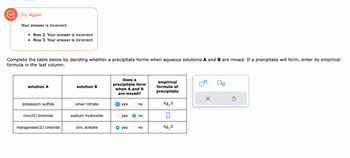Complete the table below by deciding whether a precipitate forms when aqueous solutions A and B are mixed. If a precipitate will form, enter its empirical formula in the last column. solution A potassium sulfide iron(II) bromide manganese(II) chloride solution B silver nitrate sodium hydroxide zinc acetate Does a precipitate form when A and B are mixed? yes O yes O yes no Ono no empirical formula of precipitate 0 0 0 X 00
Complete the table below by deciding whether a precipitate forms when aqueous solutions A and B are mixed. If a precipitate will form, enter its empirical formula in the last column. solution A potassium sulfide iron(II) bromide manganese(II) chloride solution B silver nitrate sodium hydroxide zinc acetate Does a precipitate form when A and B are mixed? yes O yes O yes no Ono no empirical formula of precipitate 0 0 0 X 00
Chemistry
10th Edition
ISBN:9781305957404
Author:Steven S. Zumdahl, Susan A. Zumdahl, Donald J. DeCoste
Publisher:Steven S. Zumdahl, Susan A. Zumdahl, Donald J. DeCoste
Chapter1: Chemical Foundations
Section: Chapter Questions
Problem 1RQ: Define and explain the differences between the following terms. a. law and theory b. theory and...
Related questions
Question

Transcribed Image Text:**Precipitation Reaction Table**
Complete the table below by deciding whether a precipitate forms when aqueous solutions A and B are mixed. If a precipitate will form, enter its empirical formula in the last column.
| **Solution A** | **Solution B** | **Does a precipitate form when A and B are mixed?** | **Empirical formula of precipitate** |
|------------------------|-------------------|----------------------------------------------------|--------------------------------------|
| Potassium sulfide | Silver nitrate | Yes | |
| Iron(II) bromide | Sodium hydroxide | Yes | |
| Manganese(II) chloride | Zinc acetate | No | |
**Instructions:**
- For each pair of solutions, determine if they form a precipitate.
- If a precipitate forms, write its empirical formula in the provided space.
**Diagram Analysis:**
The image contains a table with clickable options to select "yes" or "no" for the precipitation question. Empty boxes are provided to fill in the empirical formulas if a precipitate forms.
Expert Solution
This question has been solved!
Explore an expertly crafted, step-by-step solution for a thorough understanding of key concepts.
Step by step
Solved in 4 steps

Follow-up Questions
Read through expert solutions to related follow-up questions below.
Follow-up Question

Transcribed Image Text:**Exercise: Predicting Precipitate Formation**
When mixing aqueous solutions, understanding precipitation reactions is crucial in predicting product formation. Analyze the table below to determine if a precipitate forms when solutions A and B are mixed. If a precipitate forms, record its empirical formula in the final column.
---
**Feedback Section:**
- **Try Again**
- Your answer is incorrect.
- Row 2: Your answer is incorrect.
- Row 3: Your answer is incorrect.
---
**Table: Precipitation Reactions**
| Solution A | Solution B | Does a precipitate form when A and B are mixed? | Empirical formula of precipitate |
|---------------------|--------------------|------------------------------------------------|----------------------------------|
| Potassium sulfide | Silver nitrate | ● yes ○ no | Ag₂S |
| Iron(II) bromide | Sodium hydroxide | ○ yes ● no | |
| Manganese(II) chloride | Zinc acetate | ● yes ○ no | Ag₂S |
**Legend:**
- "●" indicates the selected option.
- "○" indicates the unselected option.
**Explanation:**
- In Row 1, mixing potassium sulfide and silver nitrate results in the formation of a precipitate, silver sulfide (Ag₂S).
- Row 2 indicates no precipitate forms when iron(II) bromide and sodium hydroxide are combined.
- In Row 3, mixing manganese(II) chloride and zinc acetate was incorrectly marked; however, no precipitate should result in an empirical formula. Correct evaluation needed.
---
**Interactive Elements:**
The interface includes an opportunity to revise answers and resubmit for evaluation.
Solution
Knowledge Booster
Learn more about
Need a deep-dive on the concept behind this application? Look no further. Learn more about this topic, chemistry and related others by exploring similar questions and additional content below.Recommended textbooks for you

Chemistry
Chemistry
ISBN:
9781305957404
Author:
Steven S. Zumdahl, Susan A. Zumdahl, Donald J. DeCoste
Publisher:
Cengage Learning

Chemistry
Chemistry
ISBN:
9781259911156
Author:
Raymond Chang Dr., Jason Overby Professor
Publisher:
McGraw-Hill Education

Principles of Instrumental Analysis
Chemistry
ISBN:
9781305577213
Author:
Douglas A. Skoog, F. James Holler, Stanley R. Crouch
Publisher:
Cengage Learning

Chemistry
Chemistry
ISBN:
9781305957404
Author:
Steven S. Zumdahl, Susan A. Zumdahl, Donald J. DeCoste
Publisher:
Cengage Learning

Chemistry
Chemistry
ISBN:
9781259911156
Author:
Raymond Chang Dr., Jason Overby Professor
Publisher:
McGraw-Hill Education

Principles of Instrumental Analysis
Chemistry
ISBN:
9781305577213
Author:
Douglas A. Skoog, F. James Holler, Stanley R. Crouch
Publisher:
Cengage Learning

Organic Chemistry
Chemistry
ISBN:
9780078021558
Author:
Janice Gorzynski Smith Dr.
Publisher:
McGraw-Hill Education

Chemistry: Principles and Reactions
Chemistry
ISBN:
9781305079373
Author:
William L. Masterton, Cecile N. Hurley
Publisher:
Cengage Learning

Elementary Principles of Chemical Processes, Bind…
Chemistry
ISBN:
9781118431221
Author:
Richard M. Felder, Ronald W. Rousseau, Lisa G. Bullard
Publisher:
WILEY